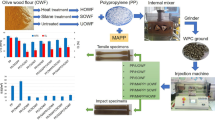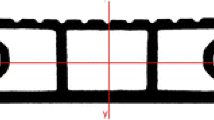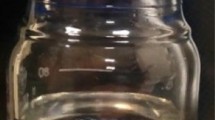Abstract
Wide-angle X-ray scattering (WAXS) and scanning electron microscopy (SEM) were used to investigate the effect of chemical modifications of wood as well as processing parameters on the supermolecular structure and morphology of wood/polypropylene (PP) composites. The surface of the filler was modified to enhance the adhesion between hydrophilic cellulose and hydrophobic polymer. Wood modification was performed by esterification with anhydrides (maleic, propionic, phthalic, crotonic and succinic) and by physical treatment with NaOH. The composites for structural characterization were prepared by the compression moulding method and injection technique. A new design of the compression mould, which ensured the wood pulling, was proposed. It was found that the polymorphs of PP matrix developed due to melt-shearing strongly depended on the pulling temperature as well as on the type chemical modification of wood. The modification of wood caused a significant decrease in the ability to generate the hexagonal phase of PP. Moreover, at a higher temperature of the mould, the amount of hexagonal phase of PP matrix slightly decreases. These investigations are very significant because characterize influence of real parameters processing as well as surface modification of filler on structure of composite materials.






Similar content being viewed by others
References
Nunez AJ, Sturm PC, Kenny JM, Aranguren MJ, Marconich NE, Reboredo MM (2003) Mechanical characterization of polypropylene-woodflour composites. Appl Polym Sci 88:1420–1428
Bledzki AK, Letman M, Viksne A, Rence L (2005) A comparison of compounding processes and wood type for wood fibre—PP composites. Composites A 36:789−797
Zafeiropoulos NE, Williams DR, Baillie CA, Matthews FL (2002) Engineering and characterisation of the interface in flax fibre/polypropylene composite materials. Part I. Development and investigation of surface treatments. Composites A 33:1083–1093
Harper D, Wolcott M (2004) Interaction between coupling agent and lubricants in wood-polypropylene composites. Composites A 35:385–394
Abdelmouleh M, Boufi S, Belgacem MN, Dufresne A (2007) Short natural-fibre reinforced polyethylene and natural rubber composites: effect of silane coupling agents and fibres loading. Compos Sci Technol 67:1627–1639
Borysiak S, Paukszta D, Helwig M (2006) Flammability of wood-polypropylene composites. Polym Degrad Stab 91:3339–3343
Kuruvilla J, Sabu T, Pavithran C (1996) Effect of chemical treatment on the tensile properties of short sisal fibre-reinforced polyethylene composites. Polymer 37:5139–5149
Hill CAS (2006) Wood modification: chemical, thermal and other processes. Wiley, New York
Mahlberg R, Paajanen L, Nurmi A, Kivisto A, Koskela K, Rowell RM (2001) Effect of chemical modification of wood on the mechanical and adhesion properties of wood fiber/polypropylene fiber and polypropylene/veneer composites. Holz Roh-Werkst 59:319–326
Balasuriya PW, Ye L, Mai YW, Wu J (2002) Mechanical properties of wood flake-polyethylene composites. II. Interface modification. J Appl Polym Sci 83:2505–2521
Albano C, Ichazo M, Gonzalez J, Delgado M, Poleo R (2001) Effects of filler treatments on the mechanical and morphological behavior of PP+wood flour and PP+sisal fiber. Mater Res Innov 4:284–293
Ellis WD, O’Dell JL (1999) Wood-polymer composites made with acrylic monomers, isocyanate, and maleic anhydride. J Appl Polym Sci 73:2493–2505
Joly C, Kofman M, Gauthier R (1996) Polypropylene/cellulosic fiber composites: chemical treatment of the cellulose assuming compatibilization between the two materials. J Macromol Sci Pure Appl Chem 12:1981–1996
Wu J, Yu D, Chan CM, Kim J, Mai YW (2000) Effect of fiber pretreatment condition on the interfacial strength and mechanical properties of wood fiber/PP composites. J Appl Polym Sci 76:1000–1010
Kazayawoko M, Balatinecz JJ, Matuana LM (1999) Surface modification and adhesion mechanisms in woodfiber-polypropylene composites. J Mater Sci 34:6189–6199
Keith HD, Padden FJ (1959) Evidence for a second crystal form of polypropylene. J Appl Phys 30:1485–1487
Natta G, Corradini P (1960) Structure of properties of isotactic polypropylene. Nuovo Cimento 15:40–51
Leugering HJ, Kirsch G (1973) Effect of crystallization from oriented melts on crystal structure of isotactic polypropylene. Angew Makromol Chem 33:17–23
Janeschitz-Kriegl H, Ratajski E, Wippel H (1999) The physics of athermal nuclei in polymer crystallization. Colloid Polym Sci 277:217–226
Kumaraswamy G, Kornfield JA, Yeh F, Hsiao B (2002) Shear-enhanced crystallization in isotactic polypropylene. 3. Evidence for a kinetic pathway to nucleation. Macromolecules 35:1762–1769
Koscher E, Fulchiron R (2002) Influence of shear on polypropylene crystallization: morphology development and kinetics. Polymer 43:6931–6942
Huo H, Meng Y, Li H, Jiang S, An L (2004) Influence of shear on polypropylene crystallization kinetics. Eur Phys J 15:167–175
Somani RH, Yang L, Hsiao BS, Fruitwala H (2003) Nature of shear-induced primary nuclei in iPP melt. J Macromol Sci 42:515–531
Bashir GC, Odell JA, Keller A (1986) Stiff and strong polyethylene with shish kebab morphology by continuous melt extrusion. J Mater Sci 21:3993–4002
Trotignon JP, Verdu J (1990) Effect of the holding pressure on the skin-core morphology of injection-molded polypropylene parts. J Appl Polym Sci 39:1215–1217
Kalay G, Bevis MJ (1997) Processing and physical property relationships in injection-molded isotactic polypropylene. 2. Morphology and crystallinity. J Polym Sci 35:265–291
Cai Y, Petermann J, Wittich H (1997) Transcrystallization in fiber-reinforced isotactic polypropylene composites in a temperature gradient. J Appl Polym Sci 65:67–75
Varga J, Karger-Kocsis J (1996) Rules of supermolecular structure formation in sheared isotactic polypropylene melts. J Polym Sci 34:657–670
Garbarczyk J, Paukszta D, Borysiak S (2002) Polymorphism of isotactic polypropylene in presence of additives, in blends and in composites. J Macromol Sci Phys 41:1267–1278
Garbarczyk J, Borysiak S (2004) Influence of the pulling of embedded natural fibres on the crystal structure of polypropylene matrix. Int J Polym Mater 53:725–733
Assouline E, Pohl S, Fulchiron R, Gerard JF, Lustiger A, Wagner HD, Marom G (2000) The kinetics of α and β transcrystallization in fibre-reinforced polypropylene. Polymer 41:7843–7854
Varga J, Karger-Kocsis J (1994) The difference between transcrystallization and shear-induced cylindritic crystallization in fibre-reinforced polypropylene composites. J Mater Sci Lett 13:1069–1071
Garbarczyk J, Borysiak S (2004) Cellulose fiber-polypropylene composites. I. The influence of extrusion and injection parameters on the structure of polypropylene matrice. Polimery 49:541–546
Borysiak S, Garbarczyk J (2003) Applying the WAXS method to estimate the supermolecular structure of cellulose fibres after mercerisation. Fibres Textiles East Eur 11:104–107
Borysiak S (2007) Determination of nucleation ability of wood for non-isothermal crystallisation of polypropylene. J Therm Anal Calorim 88:455–462
Borysiak S, Doczekalska B (2006) Influence of chemical modification of wood on the crystallisation of polypropylene. Holz Roh-Werkstoff 64:451–454
Hindeleh AM, Johnson DJ (1971) The resolution of multipeak data in fibre science. J Phys Appl Phys 4:259–263
Rabiej S (1991) A comparison of two X-ray diffraction procedures for crystallinity determination. Eur Polym J 27:947–954
Turner-Jones A, Aizlewood JM, Beckett DR (1964) Crystalline forms of isotactic polypropylene. Makromol Chem 75:134–158
Scudla J, Raab M, Eichhorn KJ, Strachota A (2003) Formation and transformation of hierarchical structure of β-nucleated polypropylene characterized by X-ray diffraction, differential scanning calorimetry and scanning electron microscopy. Polymer 44:4655–4664
Zhu P, Tung J, Phillips A, Edwards G (2006) Morphological development of oriented isotactic polypropylene in the presence of a nucleating agent. Macromolecules 39:1821–1831
Farah M, Bretas RES (2004) Characterization of i-PP shear-induced crystallization layers developed in a slit die. J Appl Polym Sci 91:3528–3541
Chen L, Shen K (2000) Biaxial self-reinforcement of isotactic polypropylene prepared in uniaxial oscillating stress field by injection molding. II. Morphology. J Appl Polym Sci 78:1911–1917
Varga J (1986) Melting memory effect of the β-modification of polypropylene. J Thermal Anal 31:165–172
Varga J (1992) Supermolecular structure of isotatic polypropylene. J Mater Sci 27:2557–2579
Cho K, Saheb DN, Yang H, Kang B, Kim J, Lee SS (2003) Memory effect of locally ordered α-phase in the melting and phase transformation behavior of β-isotactic polypropylene. Polymer 44:4053–4059
Cho K, Saheb DN, Choi J, Yang H (2002) Real time in situ X-ray diffraction studies on the melting memory effect in the crystallization of β-isotactic polypropylene. Polymer 43:1407–1416
Lotz B (1998) α and β phases of isotactic polypropylene: a case of growth kinetics phase reentrency in polymer crystallization. Polymer 39:4561–4567
Lezak E, Bartczak Z, Galeski A (2006) Plastic deformation behavior of β-phase isotactic polypropylene in plane-strain compression at room temperature. Polymer 47:8562–8574
Garbarczyk J (1985) A study on the mechanism of polymorphic transition β→α in isotactic polypropylene. Makromol Chem 186:2145–2151
Varga J, Mudra I, Ehrenstein GW (1999) Highly active thermally stable β-nucleating agents for isotactic polypropylene. J Appl Polym Sci 74:2357–2368
Menyhard A, Varga J, Molnar G (2006) Comparison of different-nucleators for isotactic polypropylene, characterization by DSC and temperature-modulated DSC (TMDSC) measurements. J Therm Anal Calorim 83:625–630
Xie XL, Fung KL, Li RKY, Tjong SC, Mai YW (2002) Structural and mechanical behavior of polypropylene/ maleated styrene-(ethylene-co-butylene)-styrene/sisal fiber composites prepared by injection molding. J Polym Sci 40:1214–1222
Wang C, Liu CR (1999) Transcrystallization of polypropylene composites: nucleating ability of fibres. Polymer 40:289–298
Somani RH, Hsiao BS, Nogales A (2001) Structure development during shear flow induced crystallization of i-PP. In situ wide-angle X-ray diffraction study. Macromolecules 34:5902–5909
Borysiak S, Doczekalska B (2009) The influence of chemical modification of wood on its nucleation ability in polypropylene composites. Polimery 54:41–48
Pompe G, Mader E (2000) Experimental detection of a transcrystalline interphase in glassfibre/polypropylene composites. Compos Sci Technol 60:2159–2167
Acknowledgements
This research was supported by Grant of Poznan University of Technology 32-171/09-DS.
Author information
Authors and Affiliations
Corresponding author
Rights and permissions
About this article
Cite this article
Borysiak, S. Supermolecular structure of wood/polypropylene composites: I. The influence of processing parameters and chemical treatment of the filler. Polym. Bull. 64, 275–290 (2010). https://doi.org/10.1007/s00289-009-0202-4
Received:
Revised:
Accepted:
Published:
Issue Date:
DOI: https://doi.org/10.1007/s00289-009-0202-4




